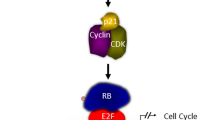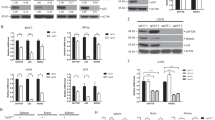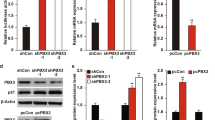Abstract
Loss of function of the retinoblastoma protein, pRB, leads to lack of differentiation, hyperproliferation and apoptosis. Inactivation of pRB results in deregulated E2F activity, which in turn induces entry to S-phase and apoptosis. Induction of apoptosis by either the loss of pRB or the deregulation of E2F activity occurs via both p53-dependent and p53-independent mechanisms. The mechanism by which E2F induces apoptosis is still unclear. Here we show that E2F1 directly regulates the expression of Apaf-1, the gene for apoptosis protease-activating factor 1. These results provide a direct link between the deregulation of the pRB pathway and apoptosis. Furthermore, because the pRB pathway is functionally inactivated in most cancers, the identification of Apaf-1 as a transcriptional target for E2F might explain the increased sensitivity of tumour cells to chemotherapy. We also show that, independently of the pRB pathway, Apaf-1 is a direct transcriptional target of p53, suggesting that p53 might sensitize cells to apoptosis by increasing Apaf-1 levels.
This is a preview of subscription content, access via your institution
Access options
Subscribe to this journal
Receive 12 print issues and online access
$209.00 per year
only $17.42 per issue
Buy this article
- Purchase on Springer Link
- Instant access to full article PDF
Prices may be subject to local taxes which are calculated during checkout






Similar content being viewed by others
References
Sherr, C. J. Cancer cell cycles. Science 274, 1672–1677 (1996).
Hanahan, D. & Weinberg, R. A. The hallmarks of cancer. Cell 100, 57–70 (2000).
Lipinski, M. M. & Jacks, T. The retinoblastoma gene family in differentiation and development. Oncogene 18, 7873–7882 (1999).
Dyson, N. The regulation of E2F by pRB-family proteins. Genes Dev. 12, 2245–2262 (1998).
Müller, H. & Helin, K. The E2F transcription factors: key regulators of cell proliferation. Biochim. Biophys. Acta 1470, M1–M12 (2000).
Wu, X. & Levine, A. J. p53 and E2F-1 cooperate to mediate apoptosis. Proc. Natl Acad. Sci. USA 91, 3602–3606 (1994).
Qin, X.-Q., Livingston, D. M., Kaelin, W. G. & Adams, P. Deregulated E2F1 expression leads to S-phase entry and p53-mediated apoptosis. Proc. Natl Acad. Sci. USA 91, 10918–10922 (1994).
Kowalik, T. F., DeGregori, J., Schwarz, J. K. & Nevins, J. R. E2F1 overexpression in quiescent fibroblasts leads to induction of cellular DNA synthesis and apoptosis. J. Virol. 69, 2491–2500 (1995).
Hsieh, J.-K., Fredersdorf, S., Kouzarides, T., Martin, K. & Lu, X. E2F1-induced apoptosis requires DNA binding but not transactivation and is inhibited by the retinoblastoma protein through direct interaction. Genes Dev. 11, 1840–1852 (1997).
Nip, J. et al. E2F-1 cooperates with topoisomerase II inhibition and DNA damage to selectively augment p53-independent apoptosis. Mol. Cell. Biol. 17, 1049–1056 (1997).
Phillips, A. C., Bates, S., Ryan, K. M., Helin, K. & Vousden, K. Induction of DNA synthesis and apoptosis are separable functions of E2F-1. Genes Dev. 11, 1853–1863 (1997).
Holmberg, C., Helin, K., Sehested, M. & Karlström, O. E2F-1 induced p53-independent apoptosis in transgenic mice. Oncogene 17, 143–155 (1998).
Vigo, E. et al. CDC25A phosphatase is a target of E2F and is required for efficient E2F-1 induced S phase. Mol. Cell. Biol. 19, 6379–6395 (1999).
Irwin, M. et al. Role for the p53 homologue p73 in E2F-1-induced apoptosis. Nature 407, 645–648 (2000).
Lissy, N. A., Davis, P. K., Irwin, M., Kaelin W. G., Jr & Dowdy, S. F. A common E2F-1 and p73 pathway mediates cell death induced by TCR activation. Nature 407, 642–645 (2000).
Tsai, K. Y. et al. Mutation of E2F1 supresses apoptosis and inappropriate S-phase entry and extends survival of Rb-deficient mouse embryos. Mol. Cell 2, 293–304 (1998).
Bates, S. et al. p14ARF links the tumour suppressors RB and p53. Nature 395, 124–125 (1998).
Sherr, C. J. Tumor surveillance via ARF-p53 pathway. Genes Dev. 12, 2984–2991 (1998).
Jost, C. A., Marin, M. C. & Kaelin, W. G. p73 is a human p53-related protein that can induce apoptosis. Nature 389, 191–194 (1997).
Kessis, T. D. et al. Human papillomavirus 16 E6 expression disrupts the p53-mediated cellular response to DNA damage. Proc. Natl Acad. Sci. USA 90, 3988–3992 (1993).
Hengartner, M. O. The biochemistry of apoptosis. Nature 407, 770–776 (2000).
Cecconi, F., Alvarez-Bolado, G., Meyer, B. M., Roth, K. A. & Gruss, P. Apaf-1 (CED-4 homolog) regulates programmed cell death in mammalian development. Cell 94, 727–737 (1998).
Yoshida, H. et al. Apaf-1 is required for mitochondrial pathways of apoptosis and brain development. Cell 94, 739–750 (1998).
Soengas, M. S. et al. Apaf-1 and Caspase-9 in p53-dependent apoptosis and tumor inhibition. Science 284, 156–159 (1999).
Macleod, K. F., Hu, Y. & Jacks, T. Loss of Rb activates both p53-dependent and independent cell death pathways in the developing mouse nervous system. EMBO J. 15, 6178–6188 (1996).
Rodriguez, J. & Lazebnik, Y. Caspase-9 and APAF-1 form an active holoenzyme. Genes Dev. 13, 3179–3184 (1999).
Hausmann, G. et al. Pro-apoptotic apoptosis protease-activating factor 1 (Apaf-1) has a cytoplasmic localization distinct from Bcl-2 or BclXl. J. Cell Biol. 149, 623–633 (2000).
Perkins, C., Kim, C. N., Fang, G. & Bhalla, K. N. Overexpression of Apaf-1 promotes apoptosis of untreated and paclitaxel- or etoposide-treated HL-60 cells. Cancer Res. 58, 4561–4566 (1998).
Evan, G. & Littlewood, T. A matter of life or cell death. Science 281, 1317–1322 (1998).
Phillips, A. C., Ernst, M. K., Bates, S., Rice, N. R. & Vousden, K. H. E2F-1 potentiates cell death by blocking antiapoptotic signaling pathways. Mol. Cell 4, 771–781 (1999).
Zhang, H. S., Postigo, A. A. & Dean, D. C. Active transcriptional repression by Rb-E2F complex mediates G1 arrest triggered by p16INK4A, TGFβ and contact inhibition. Cell 97, 53–61 (1999).
Lasorella, A., Noseda, M., Beyna, M., Yokota, Y. & Iavarone, A. Id2 is a retinoblastoma protein target and mediates signalling by Myc oncoproteins. Nature 407, 592–598 (2000).
Soengas, M. S. et al. Inactivation of the apoptosis effector Apaf-1 in malignant melanoma. Nature 409, 207–211 (2001).
Zhou, L., Song, Z., Tittel, J. & Steller, H. HAC-1, a Drosophila homolog of APAF-1 and CED-4, functions in developmental- and radiation-induced apoptosis. Mol. Cell 4, 745–755 (1999).
Ohtani, K., DeGregori, J. & Nevins, J. R. Regulation of the cyclin E gene by transcription factor E2F1. Proc. Natl Acad. Sci. USA 92, 12146–12150 (1995).
Fearnhead, H. O. et al. Oncogene-dependent apoptosis is mediated by caspase-9. Proc. Natl Acad. Sci. USA 95, 13664–13669 (1998).
Goldstein, J. C., Waterhouse, N. J., Juin, P., Evan, G. I. & Green, D. R. The coordinate release of cytochrome c during apoptosis is rapid, complete and kinetically invariant. Nature Cell Biol. 2, 156–162 (2000).
Pelton, R. W., Dickinson, M. E., Moses, H. L. & Hogan, B. L. In situ hybridization analysis of TGF-β3 expression during mouse development: comparative studies with TGF-β1 and -β2. Development 110, 600–620 (1990).
Acknowledgements
We wish to dedicate this work to the memory of M.C.M.'s late husband Pierluigi Molinari. We thank E. Prosperini for technical assistance, T. Jacks for the Rb+/− mice, Y. Lazebnik and D. Huang for anti-Apaf-1 antibodies, K. Vousden for p53 expression constructs and RKO cells, J. R. Nevins for the cyclin E1 reporter construct, A. Bulfone and C. Gattuso for suggestions concerning in situ hybridization, E. Grassilli for discussions and A. Fattaey for discussions and for critical reading of the manuscript. This work was supported by grants from AIRC, FIRC, CNR, The Italian Health Ministery, AICR and the EU's TMR programme.
Author information
Authors and Affiliations
Corresponding author
Supplementary information
Figure S1 Sequence of the human APAF-1 promoter. The nucleotide sequence from -871 to +208 bp is shown.
Figure S2 Release of cytochrome c after activation of ERE2F1 with OHT, in primary wild-type or Apaf-1-/-MEFs. (PDF 830 kb)
Rights and permissions
About this article
Cite this article
Moroni, M., Hickman, E., Denchi, E. et al. Apaf-1 is a transcriptional target for E2F and p53. Nat Cell Biol 3, 552–558 (2001). https://doi.org/10.1038/35078527
Received:
Revised:
Accepted:
Published:
Issue Date:
DOI: https://doi.org/10.1038/35078527
This article is cited by
-
Prognostic value of IKBIP in papillary renal cell carcinoma
BMC Urology (2023)
-
Mechanisms of UV-induced human lymphocyte apoptosis
Biophysical Reviews (2023)
-
Activated Src requires Cadherin-11, Rac, and gp130 for Stat3 activation and survival of mouse Balb/c3T3 fibroblasts
Cancer Gene Therapy (2022)
-
Exosomes derived from human umbilical cord MSCs rejuvenate aged MSCs and enhance their functions for myocardial repair
Stem Cell Research & Therapy (2020)
-
Programmed expression of pro-apoptotic BMCC1 during apoptosis, triggered by DNA damage in neuroblastoma cells
BMC Cancer (2019)



